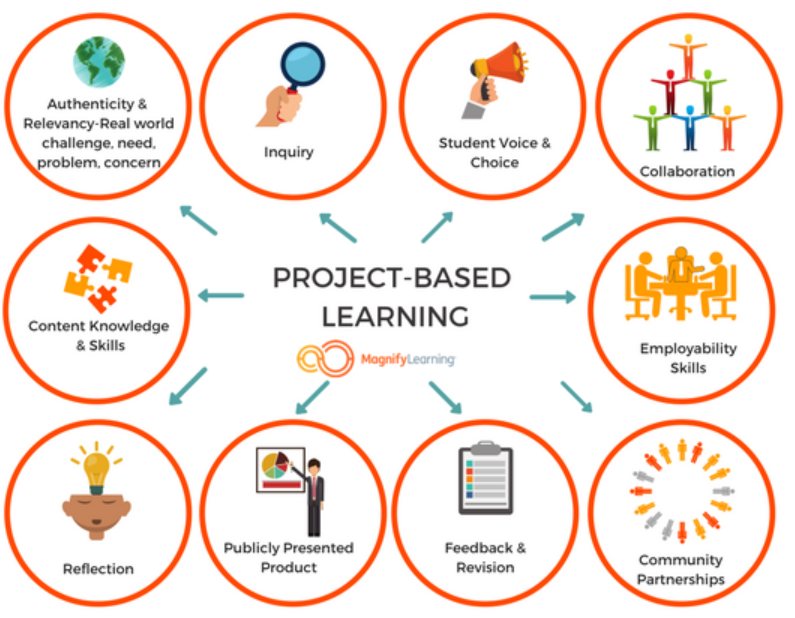Project-Based Learning
Experiential Education

Objectives:
- What project-based learning is
- Key elements of the project-based learning process
- What research reveals about project-based learning
- Skills learned during project-based learning
What is Project-Based Learning (or PBL)?
Project-based learning (PBL) is best described as learning by doing. It is a teaching and learning approach that involves working on a problem or challenge over a period of time.
The projects are usually based on real-world issues and are often complex in nature. They could take anywhere from a week to an entire term, or longer, to complete. Because of the authenticity and complexity of the projects, people who engage in this type of learning approach gain a myriad of skills and experiences around critical thinking, team work, problem-solving and reflection.
PBL is valued for the authentic learning experiences it provides, its ability to promote deeper levels of thinking and learning and, through collaborative effort, the production of high quality artefact or product.

Key Elements of PBL
While the key features of PBL vary depending on what sources you read, the most common elements are listed below with a description of what is involved with each aspect:
1. A challenging problem or question that leads the project (called the ‘driving question’) based on real-world situations/problems
Arguably the most important feature of the PBL, the probing and complex question must be ‘meaningful and anchored in a real-world situation’ (Krajcik & Blumenfeld 2006, p.321). The driving question should be open-ended and something that can be answered through the project-based learning process.
Krajcik & Blumenfeld 2006 (2006, p. 321) outline the key components of ‘a good driving question’ in that it should be feasible, meaningful, contextualised, ethical and worthwhile.
2. Ongoing enquiry and investigation
Participants of PBL are encouraged to engage in an extended period of enquiry and investigation. Through this process they will obtain information, revise their processes and apply these findings to the final outcome.
3. Innovation and creativity that results in an artefact or product
One reason PBL is effective and engaging as a learning approach is because it enables participants to have choice and voice in the creative process. Since it is student-centred, participants are encouraged to be innovative with the information they’ve obtained, particularly when constructing the final product/artefact (BIE 2018).
4. Collaboration and constructivist approach with team members
Essential to PBL is the collaboration amongst participants at all stages of the project. The constructivist approach simply means that each participant learns from, and makes their own meaning from, each experience. That is, they ‘construct’ their knowledge. This shared knowledge and social interaction enriches the PBL process and leads to deeper levels of thinking and learning.
5. Feedback, reflect and refine the artefact/product
Engaging in the reflective process is an important cyclical stage during the PBL process. Participants are encouraged to provide feedback on their progress, critique each other’s work, reflect on successes and challenges and refine the process and product going forward. This ongoing reflection and feedback loop ensures continual learning and improvement.
6. A public product for an authentic audience
PBL is unique in that there is usually an end product or artefact. In the PBL process this outcome should be showcased to an authentic audience.
(NSW Department of Education 2018)
The graphic below provides an illustration of PBL features:

(Miami Dade College 2018)
(Miami Dade College 2018)
Note: People often confuse project-based learning (mostly undertaken in an education context) with problem-based learning (a training approach usually utilised in specific fields, such as medicine). If you would like to know more about the differences between them (as well as the similarities), the video below explains. This video is aimed primarily at teachers, or individuals in charge of setting up the project.
Project vs Problem-Based Learning (21st Century Education) | 5:55 mins

PBL: What the research says (in brief)
In 1959 John Dewey, educator and philosopher, believed that students would be better invested in learning if it were situated in real-life context with meaningful problems to solve (cited in Blumenfeld & Krajcik 2006).
According to researchers, PBL is effective not only for this reason, but also for the following:
- it enables the shared construction of knowledge;
- it is a situated learning experience grounded in real-life context;
- finally, PBL allows for social interactions and growth of a community of learners (Krajcik & Blumenfeld 2006).
Thomas’ review of research on PBL concluded that PBL improves the quality of what students learn in subject matter and is an effective method to teach planning, problem-solving, decision-making and communication skills (cited in BIE 2018).

The Skills of Project-based Learning
While PBL is an interesting and engaging process for learners, its greatest value lies in the attainment of transferable and employability skills. Through the effort of completing a project, participants are involved in group work, written and oral communication, organisation and planning…to name just a few.
Those who undertake PBL can find that they have, as a bonus, developed many transferable skills that are required in the 21st century, such as:
- Problem-solving
- Critical and creative thinking
- Team work
- Digital literacy
- Innovation and entrepreneurship
- Ethics
- Oral and Written Communication
- Reflection

The Challenges with PBL
Like any learning approach, there can be challenges with undertaking project-based learning.
The first, and perhaps most significant problem, can arise when the issue/problem (or ‘driving question’) is ill-defined. If the initial question on which the project is based does not meet the criteria (identified earlier in the module) then completing the project successfully can be problematic, limited or impossible.
A second challenge can be managing the time and responsibility of individual members within the group (i.e. who is doing what?). Whether you are the ‘student’ or the project organiser, monitoring the activity within the group can be difficult.
Group work can present questions and potential conflict about equity of work load amongst group members, assessment of work, and accountability. It is recommended that before undertaking a project-based learning activity, some of the issues and expectations around group work are discussed.
Along this same line, another challenge of project-based learning can be the group dynamics. PBL requires collaboration amongst team members from start to finish. Each person brings a unique set of skills and experiences to the group. Maximising those effectively and productively can be challenging, particularly when it comes to group roles and differing opinions during the process.
Help with group work and team roles is available. Here are two modules that may be of interest - Group Development and Team Roles.

To Recap:
Project-based learning is a student-centred approach to learning that involves undertaking a project over a period in collaboration with other people.
Participants of the PBL process gain a deeper understanding of the issue(s) because they are addressing a project set in a real-world context. In the process of delivering a final product to an authentic audience, participants gain valuable skills in problem-solving, critical thinking, collaboration and presentation.

Reference List
Buck Institute for Education 2018a, A Review of Research on Project Based Learning, viewed 20 November 2018, <http://www.bie.org/object/document/a_review_of_research_on_project_based_learning>.
Buck Institute for Education 2018b, What is Project Based Learning, accessed 22 November 2018, <https://www.bie.org/about/what_pbl>.
Krajcik, JS & Blumenfeld, PC 2006, ‘Project-based learning,’ in RK Sawyer (ed.), The Cambridge Handbook of the Learning Sciences, Cambridge University Press, NY, viewed 24 November 2018, <https://utas.libguides.com/c.php?g=498348&p=3412848>.
Miami Dade College 2018, Problem/Project Based Learning (PBL) Educator’s Resource: Project Based learning, viewed 22 November 2018, <https://libraryguides.mdc.edu/pbl>.
NSW Department of Education 2018, Key Elements of Project Based Learning, viewed 23 October 2018, <https://education.nsw.gov.au/teaching-and-learning/school-learning-environments-and-change/future-focused-learning-and-teaching/project-based-learning-resource-guide/introducing-project-based-learning/Key-elements-of-project-based-learning>.
Pear Tree Education 2017, Project vs problem-based learning (21st century education), YouTube video, viewed 27 November 2018, <https://www.youtube.com/watch?v=0pPriKf1f2o&feature=youtu.be>.
York College of Pennsylvania 2018, Project-based Learning, viewed 23 October 2018, <https://my.ycp.edu/web/center-for-academic-innovation/project-based-learning>.

